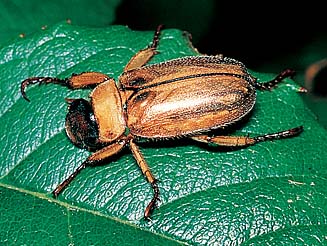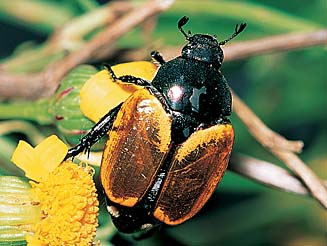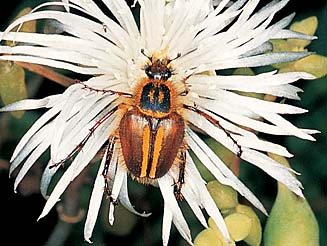|
Subfamily: Rutelinae (leaf chafers [part], white grubs
[part], monkey beetles)
Life > Eukaryotes > Opisthokonta > Metazoa (animals) > Bilateria > Ecdysozoa > Panarthropoda > Tritocerebra > Arthopoda > Mandibulata > Atelocerata > Panhexapoda > Hexapoda
> Insecta
(insects) > Dicondyla > Pterygota > Metapterygota > Neoptera > Eumetabola >
Holometabola > Coleoptera
(beetles)
> Polyphaga > Superfamily: Scarabaeoidea
> Family: Scarabaeidae
Distinguished from other Scarabaeidae by the tarsal claws
which, especially on the hindlegs, are unequally sized and movable. Larvae are
known as white grubs, a term also used for larvae of the subfamily
Melolonthinae. They feed on plant litter and plant roots in the soil, and can be
serious pests of cultivated crops and lawns.
The most diverse group of rutelines in southern Africa is
the tribe Hopliini in which adults are often
brightly coloured and hairy with large powerful hind legs and usually encountered
in flowers.
 |
 |
|
Tribe Adoretini. Adoretus ictericus (Wattle chafer), 13mm.
[image by M. Picker & C.
Griffiths ©, from Field Guide to Insects of South Africa,
used with permission]. |
Tribe Anomalini. Popillia biguttata, (Yellow shining
leaf chafer), 14mm.
[image by A. Weaving ©, from Field Guide to Insects of South Africa,
used with permission]. |
 |
|
|
Tribe Hopliini. Lepithrix pseudolineata
(Spider monkey beetle), 9mm.
[image by M. Picker & C.
Griffiths ©, from Field Guide to Insects of South Africa,
used with permission]. |
|
Page by Margie Cochrane |
